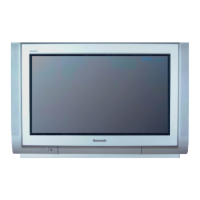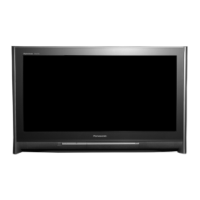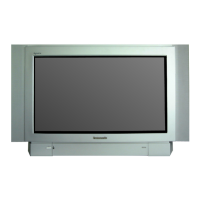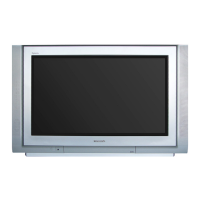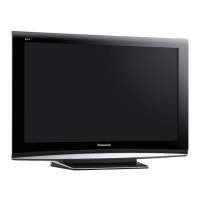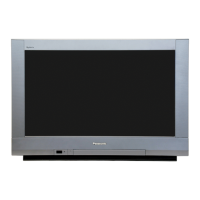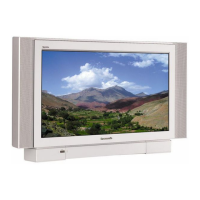
Do you have a question about the Panasonic TX-32C300B and is the answer not in the manual?
Covers operating conditions, ventilation, placement, and environmental factors for safe TV use.
Details precautions related to electric shock, power cords, plugs, and safe handling practices.
Encompasses hearing safety, fire hazards, pixel behavior, and cleaning instructions.
Instructions for cleaning the TV's exterior surfaces, including the screen, cabinet, and pedestal.
Guidance on cleaning the power plug to prevent electrical hazards.
Steps for unpacking and preparing the TV for pedestal attachment.
Detailed instructions on how to attach the TV stand to the television.
Steps for detaching the TV stand from the television.
Specifies the required dimensions for mounting a wall-hanging bracket to the TV.
Provides tips and settings to optimize TV power usage and reduce energy consumption.
A comprehensive list detailing the various capabilities and functions of the television.
Lists all items that are provided in the product packaging with the TV.
Explains system behaviors and messages displayed when the TV enters standby mode.
Describes the physical buttons located on the TV and their respective functions.
Guides users on how to operate the TV using the remote control for navigation and input selection.
Step-by-step guide for inserting AAA batteries into the TV remote control.
Instructions on how to safely connect the television to a power source or wall outlet.
Guidance on connecting the aerial or cable TV plug to the TV's input socket.
Lists and explains trademarks relevant to the television, such as HDMI and Dolby.
Provides instructions for the responsible disposal of electronic waste and batteries.
Provides contact information, including phone numbers and website for customer assistance.
Details procedures for ordering accessories and products directly from Panasonic UK.
Lists supported TV broadcasting standards, receiving channels, and digital reception capabilities.
Details screen dimensions, power consumption, operating temperature, and humidity limits.
Explains the function and purpose of each button on the television's remote control.
Details available TV ports and the corresponding cable requirements for external devices.
Offers important advice for connecting devices, including USB limits and HDMI cable types.
Guides on turning the television on, off, and managing standby mode.
Covers the initial setup steps performed when the TV is powered on for the first time.
Instructions on choosing and configuring broadcast search options like Aerial, Cable, and Analogue.
Instructions for connecting external hard drives or memory sticks to the TV's USB ports.
Information on supported file systems, device compatibility, and backup warnings for USB devices.
How to navigate and use the media browser to play photo, music, and movie files.
Details the various playback modes available for media files, such as loop and shuffle.
Explains controlling CEC-enabled devices via HDMI and passing remote control signals.
Describes the ARC feature for audio output from the TV to an audio system via HDMI.
Guides on connecting and controlling external amplifiers or receivers with the TV remote.
Covers settings like Mode, Contrast, Brightness, Sharpness, and Colour for image quality.
Explains options for optimizing power usage and adjusting the screen's backlight level.
Details advanced options such as Dynamic Contrast, Noise Reduction, and Colour Temperature.
Specific settings for optimizing the picture when using a PC as the input source.
Covers adjusting the TV's volume, equalizer modes, and speaker balance.
Details headphone volume, sound modes, AVL, and digital audio output configurations.
Covers conditional access, language, parental controls, timers, date/time, and network setup.
Details accessibility options, audio description, and subtitle configuration.
Explains settings like Menu Timeout, Blue Background, Software Upgrade, Store Mode.
Covers CEC functionality for connected devices and selecting audio output modes.
Guides on performing automatic, manual, and network channel scans for TV reception.
Covers fine-tuning analogue channels and managing the stored service list.
Explains installation settings, standby search, and how to reset the TV to factory defaults.
How to view, edit, and manage the list of available TV channels and set favourites.
Instructions for creating, managing, and filtering custom lists of preferred TV channels.
Setting up parental locks, maturity locks, and child locks for content restriction.
Using the EPG to view TV schedules, programme details, and set reminders.
Instructions for accessing and using standard and digital teletext features.
Guides on searching for and installing TV software updates via the user interface.
Addresses common issues like the TV not turning on or experiencing poor picture quality.
Helps resolve problems related to no sound or an unresponsive remote control.
Guides on troubleshooting difficulties encountered when selecting input sources.
Lists typical display modes and resolutions supported for connecting a PC to the TV.
Details supported video and audio signals for SCART, Side AV, and YPbPr connections.
Lists supported resolutions and refresh rates for various HDMI connection standards.
Lists compatible video file extensions, formats, and their playback notes for USB.
Lists compatible audio file extensions, formats, and their playback notes for USB.
Lists compatible image and subtitle file formats supported via USB connection.
Details supported resolutions and frequencies when using a DVI to HDMI converter cable.
Provides crucial instructions for safely connecting the TV to the mains supply and wiring.
Emphasizes disconnecting the equipment when not in use and avoiding exposure to moisture.
Identifies the manufacturer (Supplier) and the specific model number (Model ID) of the TV.
Lists energy efficiency class, power consumption figures, and screen resolution for the TV.

